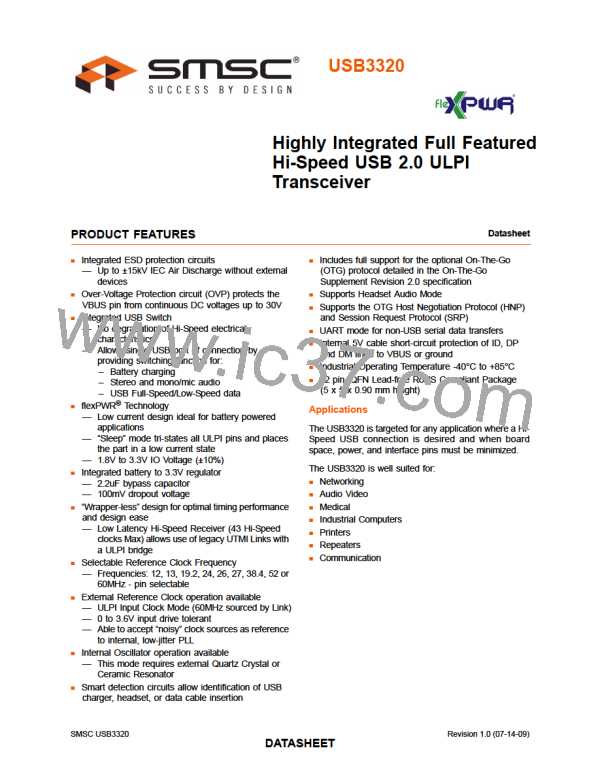Highly Integrated Full Featured Hi-Speed USB 2.0 ULPI Transceiver
Datasheet
6.4.0.2
6Pin FS/LS Serial Mode
Six pin serial mode utilizes the data bus pins for the serial functions shown in Table 6.6.
Table 6.6 Pin Definitions in 6 Pin Serial Mode
CONNECTED
SIGNAL
TO
DIRECTION
DESCRIPTION
tx_enable
tx_data
tx_se0
DATA[0]
DATA[1]
DATA[2]
DATA[3]
DATA[4]
DATA[5]
DATA[6]
DATA[7]
IN
Active High transmit enable.
IN
Tx differential data on DP/DM when tx_enable is high.
Tx SE0 on DP/DM when tx_enable is high.
Asserted when any unmasked interrupt occurs. Active high.
Single ended receive data on DP.
IN
interrupt
rx_dp
OUT
OUT
OUT
OUT
OUT
rx_dm
Single ended receive data on DM.
rx_rcv
Differential receive data from DP and DM.
Driven Low.
Reserved
6.5
Carkit Mode
The USB3320 includes Carkit Mode to support a USB UART and USB Audio Mode.
By entering Carkit Mode, the USB3320 current drain is minimized. When operating in ULPI Input Clock
Mode (60MHz REFCLK Mode), the CLKOUT is stopped to conserve power by default. The Link may
configure the 60MHz clock to continue by setting the ClockSuspendM bit of the Interface Control
register before entering Carkit Mode. If set, the 60 MHz clock will continue during the Carkit Mode of
operation.
In Carkit Mode, interrupts are possible if they have been enabled in the Carkit Interrupt Enable register.
The state of each interrupt source is sampled prior to the assertion of DIR and this is compared against
the asynchronous level from interrupt source. In Carkit Mode, the Linestate signals are not available
per the ULPI specification.
Exiting Carkit Mode is the same as exiting Low Power Mode as described in Section 6.3.2. The Link
must assert STP to signal the transceiver to exit serial mode. When the transceiver can accept a
command, DIR is de-asserted and the transceiver will wait until the Link de-asserts STP to resume
synchronous ULPI operation. The RESETB pin can also be pulsed low to reset the USB3320 and
return it to Synchronous Mode.
SMSC USB3320
Revision 1.0 (07-14-09)
DATA5S7HEET

 SMSC [ SMSC CORPORATION ]
SMSC [ SMSC CORPORATION ]